Skepticblog
About Donald Prothero
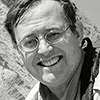
Donald R. Prothero was Professor of Geology at Occidental College in Los Angeles, and Lecturer in Geobiology at the California Institute of Technology in Pasadena. He earned M.A., M.Phil., and Ph.D. degrees in geological sciences from Columbia University in 1982, and a B.A. in geology and biology (highest honors, Phi Beta Kappa) from the University of California, Riverside. He is currently the author, co-author, editor, or co-editor of 28 books and over 250 scientific papers, including five leading geology textbooks and four trade books as well as edited symposium volumes and other technical works. He is on the editorial board of Skeptic magazine, and in the past has served as an associate or technical editor for Geology, Paleobiology and Journal of Paleontology. He is a Fellow of the Geological Society of America, the Paleontological Society, and the Linnaean Society of London, and has also received fellowships from the Guggenheim Foundation and the National Science Foundation. He has served as the President and Vice President of the Pacific Section of SEPM (Society of Sedimentary Geology), and five years as the Program Chair for the Society of Vertebrate Paleontology. In 1991, he received the Schuchert Award of the Paleontological Society for the outstanding paleontologist under the age of 40. He has also been featured on several television documentaries, including episodes of Paleoworld (BBC), Prehistoric Monsters Revealed (History Channel), Entelodon and Hyaenodon (National Geographic Channel) and Walking with Prehistoric Beasts (BBC).
RSS feed for this authorfaculty.oxy.edu/prothero
Subjects
aliens alternative medicine atheism autism belief bigfoot Brian Dunning CAM Carl Sagan climate change conspiracy theories Creation creationism critical thinking cryptozoology denialism dinosaurs Dr. Kiki earthquakes economics education environment ethics evolution fossils geology Ghost Hunting ghosts global warming God homeopathy intelligent design james randi journalism media medicine michael shermer morality nasa paleontology paranormal politics pseudoscience Psychics psychology religion science science denialism scope SETI Shermer skeptical history skepticism skeptoid Skeptologists TV ufo ufos vaccines videoRecent Comments
- Daniel Loxton commented on A Fond Farewell to Skepticblog at 1:25 pm, September 18, 2014
- markx commented on A Fond Farewell to Skepticblog at 8:52 pm, September 17, 2014
- Thomas commented on False Equivalence at 11:44 am, September 15, 2014
- John Greg commented on A Fond Farewell to Skepticblog at 2:10 pm, September 13, 2014
- tmac57 commented on A Fond Farewell to Skepticblog at 10:39 am, September 13, 2014
Read posts by author:
Dancing into an uncertain future
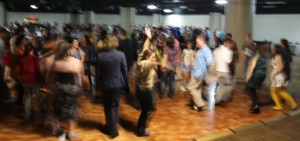
Eager young VP students dance through the night at the after-meeting party. (Photo by R. Hunt-Foster).
Last November, the 73rd annual meeting of the Society of Vertebrate Paleontology (SVP) was held here in Los Angeles. SVP is my professional society, since my primary training and research is fossil vertebrates (especially fossil mammals like rhinos, peccaries, camels, horses, and others). My first SVP was the 1977 meeting, the last time it was held here in Los Angeles, when I was just a beginning graduate student. Since then, I’ve been to every meeting of SVP, a streak of 36 years in a row. It’s my lifeline, and I wouldn’t consider missing it for anything. Once a year I get to see all my closest professional friends and colleagues, people I spent months in the field with, former officemates from grad school, and find out the latest news about people I’ve known for 30 years or more. I also present my own research (I always do at least one presentation, and sometimes my name is on several more by my students), and I usually get to see my former students as they grow and thrive in their own careers. For five years (1999-2004), I was the Program Chair, running the entire meeting and producing (editing, typesetting, etc.) the abstract volume with over 600 individual abstracts. At that point, I couldn’t miss the meeting for anything, including my brother’s wedding (I told him in advance NOT to schedule it to conflict with SVP). Most importantly, I go each year to get some positive feedback and affirmation that my 40 years of research and scholarship is valued and means something to people who appreciate it. This is essential when you spend the other 51 weeks of the year in a hostile department where they don’t appreciate you and try to tear you down at every opportunity.
comments (12)Hearts and minds
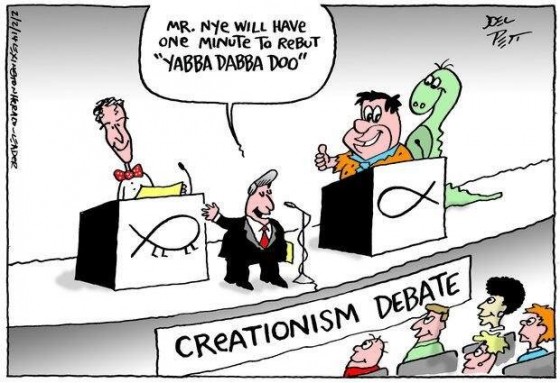
I write this post just a few hours after watching the Ham on Nye “debate” last night. I’m still mulling over the details, and checking on line to see the evolving reactions to the events, but it’s running through my head so much now that it’s time to write it down so I can get back to work. Fittingly, it will post on February 12, Darwin’s 205th birthday. It couldn’t be more appropriate.
Let me start at the beginning. I was at Michael Shermer’s New Year’s Eve party last December 31st. This is not just your average New Year’s Eve party: it’s in Shermer’s magnificent glass-walled view house at the foot of the San Gabriel Mountains with an amazing panorama of the lights of the city below. He had his telescope out on the porch, and we all got a view of the four Galilean moons of Jupiter. The guests include Mr. Deity and “Lucy” (Brian Keith Dalton and Amy Rohren), D.J. Grothe of the James Randi Educational Foundation, lots of scientists including several JPL people, Shermer’s grad students—and Bill Nye. Late in the evening, Bill comes up to me and mentions that he had agreed to debate Ken Ham. He knew I’d beaten Duane Gish back in 1983, and that I was familiar with battling creationism over the past 35 years. After I talked to him and realized that the debate was set and he could not back out, I offered to help him prepare. Then about 3 weeks ago, he emailed me and we made arrangements. He spent a day in Oakland at the National Center for Science Education (NCSE), where a bunch of their staff helped him analyze Ham’s past debates and arguments (they have archives of every creationist out there), and suggest strategies. Since Ham had voluntarily set the debate topic to defend the scientific value and truth of the Bible, Bill was not in the usual dilemma of having to defend and explain complex topics of evolution. Normally, creationists employ the “Gish Gallop” to keep the scientist on the defensive, trying to undo the mistaken ideas and lies the creationist has just said, and replace it with a more complex explanation. Instead, the NCSE staffers recommended that Bill use this to his advantage, and do a “reverse Gish Gallop”: pile on the examples one after another, so that Ham wouldn’t have time or ability to answer them all. (continue reading…)
comments (43)Adjunct professors: slave labor of academia

A plot showing the growth in number of Ph.D.’s (blue lines) versus the slow change in the academic job market (yellow lines) (From Schillebeeckx et al., 2013)
In my previous post, I talked about the dramatic differences between students and expectations in an elite four-year college vs. the two-year colleges. Implicit in the discussion was another topic that most of the public does not know about: the increasing use of underpaid adjunct faculty to teach courses throughout academia.
The topic finally broke through the media silence last fall when on September 1, Mary Margaret Vojtko, an adjunct professor of French at Duquesne University in Pittsburgh for 25 years, died of heart attack at age 83, completely penniless. The original story in the Pittsburgh Post-Gazette soon made the national and international media as the sordid details emerged. Vojtko slaved away tirelessly at Duquesne for all those years with excellent teaching evaluations and everything else that should have resulted in rewards from the university. Instead, she got an adjunct contract year after year, working for less than $25,000 a year with no benefits. She fell further and further into poverty living on those wages, until she could no longer afford a home, and was completely broke by the time she died. When caseworkers from Adult Protective Services were called in to investigate, they were shocked that she was a hard-working professor, not some sort of bum off the street, and could not imagine how someone with a Ph.D. could have fallen so low without the usual problems with drugs, alcohol, or mental illness. (continue reading…)
comments (39)How the other half lives
Ever since I was a 4-year-old, hooked on dinosaurs, I knew that I wanted to study paleontology for the rest of my life. By the time I was in fourth grade, I was the only kid in my school who knew anything about dinosaurs (this was in the early 60s, before dinosaurs became cool for kids). I was asked to lecture about them to the sixth graders, and so I knew I liked to teach. Once I got into college and followed the normal route to a career in paleontology through my Ph.D. at Columbia University and the American Museum in Natural History in New York, I was committed to becoming a college professor. Starting with teaching at Columbia and Vassar, then at Knox College in Galesburg, Illinois, and then 27 years at Occidental College in Los Angeles, and at Caltech in Pasadena, I’ve been extremely fortunate in teaching at elite institutions with outstanding students every place I’ve worked. Most of my time has been spent in small private liberal arts colleges (Vassar, Knox, and Occidental), where the classes are small and full of dedicated, bright students who mostly want to learn and generally work very hard. I got to know every student in nearly every class very quickly, and got to be good at reading their faces to make sure they understand. I always challenged them without pushing them past their breaking point. I was very proud of the mature, thoughtful scholarship our senior geology majors would produce after four years of the best teaching and opportunities. I’ve been nominated for teaching awards many times and won a few times, and I always have alumni and alumnae coming back and telling me how important my class was in opening their eyes or changing their lives. At small private colleges where the tuition is high, we give them their money’s worth with highly intensive, personalized education (I have involved hundreds of students in my research over the years, and about 45 students have more than 50 published scientific papers co-authored with me). We know immediately if a student is missing from class (it’s hard to hide in a class of eight, but even in a class of 32, I kept track). The college practically flipped out if a student missed 2-3 meetings in a row without contacting us—we were instructed to notify the Dean of Students for any student doing poorly on a test, or showing signs of slipping, since they don’t want anyone to drop out if they can help it. And we were proud of our high retention rate, and virtually all our students graduated in four years. (continue reading…)
comments (39)Autism and vaccines: correlation is not causation
Just after the beginning of the year, leading anti-vaxxer and former Playboy Playmate Jenny McCarthy was in the news again. Several years ago, she apparently told Time magazine that her son Evan didn’t have autism, but (as doctors have long suspected) Landau-Kleffner syndrome. Then in January, McCarthy made several angry denials of this old interview. Frankly, I doubt that a source like Time magazine misquoted her—I think she’s lying again. She now claims that Time magazine inaccurately reported the facts! I think my irony meter just broke. Jenny McCarthy was a washed-up actress with nothing but a series of low-brow movies and TV shows to her credit until she became the national spokeswoman for the anti-vaxxer movement—a movement which was, in a form of supreme irony, legendary for an inaccurate grasp of the facts, then shifting the goal posts on their demands when the mercury was removed from the vaccines and there was still no effect on rates of autism. She rejects mainstream science, yet cites biomedical science in support of her claim that her son really has autism. I think we should reject her claim outright, because she (like many anti-vaxxers) have no clue what mainstream science and medicine are about.
Now she and her anti-vaxx cohort are demanding that medicine and drug companies should “green the vaccine”! What the heck do they think the FDA is for? All vaccines must pass rigorous testing and quality control through the FDA, which has one of the most stringent standards for drugs and medicine in the world. Fat chance that she and her fellow science-denying protesters are going to help the process in any way! Meanwhile, she’s now on The View every day, giving an air of legitimacy to her form of pseudoscience. And the movement she bolstered is causing huge numbers of kids to go unvaccinated, get sick and sometimes die of preventable diseases—and, even worse, spread those diseases to and often kill infants too young for vaccination (even if their parents do believe in modern medicine). (continue reading…)
comments (23)It was Twenty Years Ago Today….
Twenty years ago today, January 17, was an event I shall never forget: the Northridge earthquake of 1994. Born and raised in Southern California, I’ve lived through the 1971 Sylmar quake, the 1987 Whittier quake, and many, many smaller events that most people have forgotten. The events were traumatic to anyone who experienced it, even at great distances, and for years afterwards I could remind my students about how it felt, and how it changed Los Angeles. Unfortunately, time marches on, and now that it is 20 years ago, most of my college students either were too young to remember, or were not even born yet!
It struck at 4:31 in the morning, in total pre-dawn darkness, on a Monday that was the Martin Luther King holiday. Luckily, it meant that most people were sleeping and fewer than usual were headed to work, so the casualties were much less than if it had hit during the peak of rush hour. Even though it had a moment magnitude (Mw) of “only” 6.7, its upward acceleration of the ground motion was 1.8 g, much stronger than many quakes of the same size, and the highest ever recorded in an urban area in North America. It seemed to last a long time, although it actually lasted only 10-20 seconds. There was another Mw = 6.0 aftershock an hour later, and another 11 hours later. It was felt strongly as far as Las Vegas, an unusually long distance for southern California quakes (which tend not to propagate very far because of the shattered, highly faulted blocks in our crustal rocks don’t transfer energy well). Contrary to the name, its epicenter was not Northridge, but in Reseda, a town to the south—and both were very close to where I now teach at Pierce College in Woodland Hills. The initial reports of the magnitude as 6.6 and the epicenter at Northridge proved to be wrong once better seismic data came in a day later. (continue reading…)
comments (7)Bigfoot meets “Reality” TV
I can just see it now: Mike Riley and his production team, veterans of previous “reality” TV shows such as “Yukon Men,” “Cram”, “Tool Academy”, and many others, are brainstorming ideas for another new show. Several new Bigfoot shows have just aired on basic cable TV, so someone says “Why don’t we combine ‘Survivor’ with Bigfoot?” I’m sure something along these lines occurred: take a classic “reality” TV format, the competition show between individuals or teams (such as “Survivor” or “The Amazing Race”), and give them a new pop-culture task to perform: finding Bigfoot. This, in a nutshell, is what Spike TV’s new show “The $10 Million Bigfoot Bounty” (first aired on Jan. 10) is all about.
Just like the format of other competition “reality” TV shows, they have 9 teams of 2 people told to perform a difficult task: seeking evidence of Bigfoot in the woods of Washington and California. Each week another team is eliminated for failing to come up with something, and the race gets tougher. If any contestant comes up with good evidence of Bigfoot, they win the $10 million prize. During each episode, they follow a standard format: some sort of competition to see if they have the “skills” to do the job, and then a night search for “evidence of Bigfoot”—plus the usual footage of the contestants at the beginning and end of each competition, and a final “elimination” segment when they milk the “who gets kicked out?” storyline for the maximum amount of drama. They follow all the stereotypical conventions of this genre: spooky music, lots of reaction shots of contestants under stress, big pause before they announce the loser then cut to a long commercial break before the reveal, etc. And, like any reality show, lots of footage of the contestants arguing and bickering with each other, saying stupid things, and just plain making fools of themselves in front of millions of viewers. (Word of advice: pre-record the show and watch it later with your remote control. Almost half the time is killed by obnoxious advertisements).
comments (9)Area 51: Myth and Reality
Come join the Skeptic Society for our trip to Area 51 and other alien landscapes, Martin Luther King weekend (January 18-20), 2014. We will spend 3 days exploring the “Extraterrestrial Highway” (with lunch at the Little A’Le’inn), collecting trilobites, and visiting the National Atomic Testing Museum and their UFO exhibit, as well as the alien landscape of Valley of Fire State Park and Calico Ghost Town. Both nights will be spent at the MGM Grand Hotel in Las Vegas. For further details, see this link. Hurry! We’re down to our last few seats!
In the past few decades, this perfectly ordinary military base in the middle of the desert in southern Nevada has taken on mythic status. Most military bases have tight security, and only authorized military personnel and their contractors are allowed on base. This particular base is top secret, with much tighter security than most military land. Not only is it surrounded by a secured perimeter and motion detectors in the ground, but the guards travel the perimeter regularly, and have video security cameras monitoring everything that comes near the fence. It is also located in one of the most remote areas of sparsely populated Nevada, more than two hours of driving north out of Las Vegas. Because there is no way to see the base from the paved road, even from the highest peaks outside the base except Tikaboo Peak (a long hard desert hike), it can only be viewed from the air or from space. Naturally, that high level of secrecy has led to all sorts of speculation about what happens there, and an entire industry of books and movies and TV shows which need only mention the phrase “Area 51” and immediately their audience assumes that there are aliens or some kinds of weird government experiments going on there. (continue reading…)
comments (9)Happy New Tap-Year!
For my New Year’s Day post, I thought I’d review some of the important zoological discoveries of 2013, especially regarding new species that have just been discovered. A few weeks ago, the word came out that a new species of tapir (pronounced TAY-pir, they are a pig-sized group of mammals with a long proboscis and three to four toes, distantly related to rhinos) had just been found and formally described. For most of us in the life sciences, this is exciting if not exactly earth-shaking news. As our techniques for identifying new species are getting better and better, we are finding more and more examples of creatures that were known to the local indigenous peoples, but not yet recognized by zoologists. In most cases, these new species are only subtly different from previously described species, so zoologists may have seen the creature before, but not yet recognized that it was a different species from its more familiar close relatives. In many cases, the specimens may have already been collected and were sitting in museums, misidentified. This is particularly true in the case of new species that don’t look that different externally (sibling species), but can be distinguished based on more subtle differences. In the old days, sibling species had to be identified based on things like behavior. Now, there are a number of new species recognized based on molecular differences that are not manifested in anatomical differences we can see with the naked eye. (continue reading…)
comments (2)Hosted by Skeptic magazine. For website-related matters, contact the webmaster.
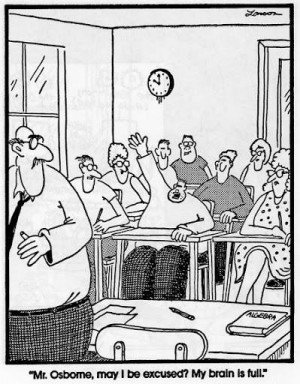
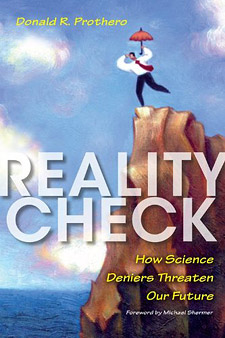
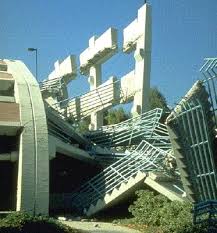
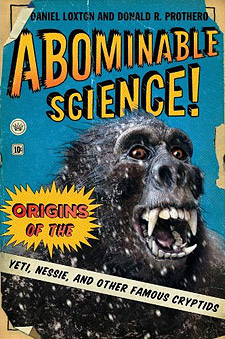

One of the recurring themes at the Feb. 4 debate between Bill Nye and Ken Ham was Ham’s continuously harping on a supposed distinction between “observational science” (science we can observe in real time) and “historical science” (science that must be inferred from the past). This strange distinction is almost unique to Ken Ham, although I’m sure he borrowed from older creationist writings somewhere, since I remember reading about it when I researched creationism in the 1980s. Nevertheless, Ham kept pounding on it again and again, refusing to talk about any scientific evidence that couldn’t be witnessed in real time.
As many scientists have discussed, this distinction is complete bunk, and only Ken Ham and his followers seem to think that it makes any sense. Naturally, he pounds on this phony, self-serving, artificial distinction because it plays in his favor. Each time Bill pressed him on one point or another, Ham retreated behind his dodge of no one can know anything of “historical” past, then made the ridiculous assertion that the only reliable source of information about the past is the Bible. (Bill was too much of a gentleman to challenge him on this and ask Ken how he knows this. As Ham always says, “Were you there?”). Most of science tells us that the earth is old, that life has evolved, and so on. Ham wants to throw all this information away, so he creates a convenient but ridiculous distinction that serves his purposes—but bears no relation to what real scientists do or think. (continue reading…)
comments (16)